
12 Jan 2005
Updated 5 Jan 2015, 9 Skull (SR), Atonement (UE)
©2005, 2015 by John P. Pratt. All rights Reserved.
| 1. Statistical Evidence of God |
| 2. Earthquakes and Trumpets |
| 2.1 Enoch Fixed Calendar |
| 2.2 Feast of Trumpets |
| 2.3 Names of Enoch Years |
| 2.4 Pentecost Correlation |
| 2.5 Great Deluge Trumpet |
| 2.6 Feast of Trumpets Tsunami |
| 3. Disasters and Sacred Calendars |
| 3.1 Other Trumpets' Tsunamis? |
| 3.2 Sacred Round |
| 3.3 Lisbon Earthquake |
| 3.4 Deaths on Skull |
| 3.5 Research Results |
| 3.6 Deluge Day |
| 3.7 Predicting the Future |
| 4. Conclusion |
| 5. Addendum |
| Notes |
Note: The correlation of the Enoch Fixed Calendar discussed in this article was later improved, and the name changed to Uniform Enoch Calendar. New discoveries have increased the validity of the conclusions of this article and are discussed in the Addendum (Section 5), added on 5 Jan 2015. The rest of the article remains as originally written.
On the morning of Sun 26 Dec 2004, a Richter 9.0 earthquake occurred in the Indian Ocean about 100 miles off the coast of Sumatra, unleashing a huge tidal wave which devastated the shores of all countries in the surrounding area. Sri Lanka and Indonesia are said to have sustained the most damage, but countries as far away as Kenya and Somalia were affected. At the time of this writing the known human death toll was over 160,000. As far as I can tell from almanacs and government seismic web sites, only four earthquakes of Richter magnitude 9 or greater occurred in the twentieth century, so this recent earthquake is among the greatest measured in modern times. It is being called the most costly in monetary amounts. Video clips of incoming waves on the luxurious beaches and from the news media of destroyed villages and children being pulled by the sea from their parent's arms have torn our hearts and burned indelible images into our memories of how destructive the forces of nature can be.
 |
The Lord has warned that he will preach his own sermons to call the world to repentance, explicitly using earthquakes and the "voice of the waves of the sea heaving themselves beyond their bounds" (Isa. 29:6, D&C 88:89-90). Was this recent event the voice of God speaking in the waves of the sea? Can we know it is from God if he does not explicitly tell us through a prophet? How are atheists supposed to recognize the hand of God in natural disasters? Why wouldn't they simply assume exactly what the news media do, that it was simply caused by random and meaningless natural forces?
This article focuses on only one of these questions. How is the atheist supposed to recognize the hand of God in nature? How is he to know that "Mother Nature" is really Heavenly Father, or his son Jesus Christ? To me, one answer is through statistical probabilities.
For example, it can be shown statistically that more earthquakes happen at new or full moons than otherwise. The law of gravity shows that tidal stresses on the earth are greatest at that time, actually causing the earth to flex many inches. It is not hard to see that such flexing and stress could lead to earthquakes along known fault lines. In fact, the recent tsunami was indeed on the day of the full moon.
Many patterns are caused by intelligent creatures such as animals and man. But when those two sources are eliminated as possibilities, scientists rarely turn to God as an explanation. Before science became sophisticated by the use of the scientific method a few centuries back, there was probably too much of a tendency to ascribe everything to God, and hence not even to try to deduce for ourselves how his laws might work. For example, one could simply assume that angels pushed the planets in their orbits around the sun, which would end the discussion and not lead to any experiments. Now the pendulum has swung the other way. We have been so successful at explaining most events of nature with natural laws that it has become tacitly forbidden even to suggest God as a possible player in the creation of a pattern. So the third alternative has been the only fall back position in most cases, that the pattern was just caused by random chance.
The problem with ascribing all patterns which do not seem to be caused by natural law to having been caused by blind chance is that often the odds are so improbable as to be ludicrous. It is much easier to believe in God than to believe that something occurred when the chances are millions to one against it.
For example, suppose you found a loaf of bread on your doorstep every morning. Surely you would conclude that some person was responsible for this pattern of events. Now suppose that it happens and you live alone in the desert with no neighbors for miles around, with no footprints in the sand near the bread. What would you think?
When the children of Israel left Egypt after having grown up for years in paganism, how were they supposed to believe in the true God? The older generation didn't, but the Lord provided an interesting method for the younger generation. He caused a bread-like substance to condense like dew nearly every morning on the ground to feed them. But wait, that could have been caused by chance, by some natural forces such as those than cause normal dew. How could they be sure that God was feeding them? That is where the statistical proof from a pattern came in.
The manna appeared only on six mornings of every week, with none on the sabbath. A double portion could be gathered on the day preceding the sabbath without it breeding worms as it did in any other attempt to store it. What are the chances that the manna would fall and behave according to that pattern? The chances are infinitesimal that it would occur for even a few weeks, much less for forty years straight! Accordingly, atheists today simply dismiss the record as a fabrication. But what if you lived at that time and witnessed it? Would you have been a believer? To me this is a clear example of God expecting to be recognized through statistical evidence.
This article provides preliminary evidence that the timing of some large natural disasters which kill thousands apparently occur more often than chance would predict on certain days of sacred calendars which have no known relation to any physical natural forces. Thus, it is proposed that this is statistical evidence that the hand of God is indeed involved in natural disasters.
There has not been time to complete an exhaustive study in the few days since the recent tsunami, but my initial results are favorable enough to report. Those results indicate that certain sacred calendars do indeed appear to be significant in the timing of earthquakes. This article will focus principally on the Enoch Fixed Calendar.
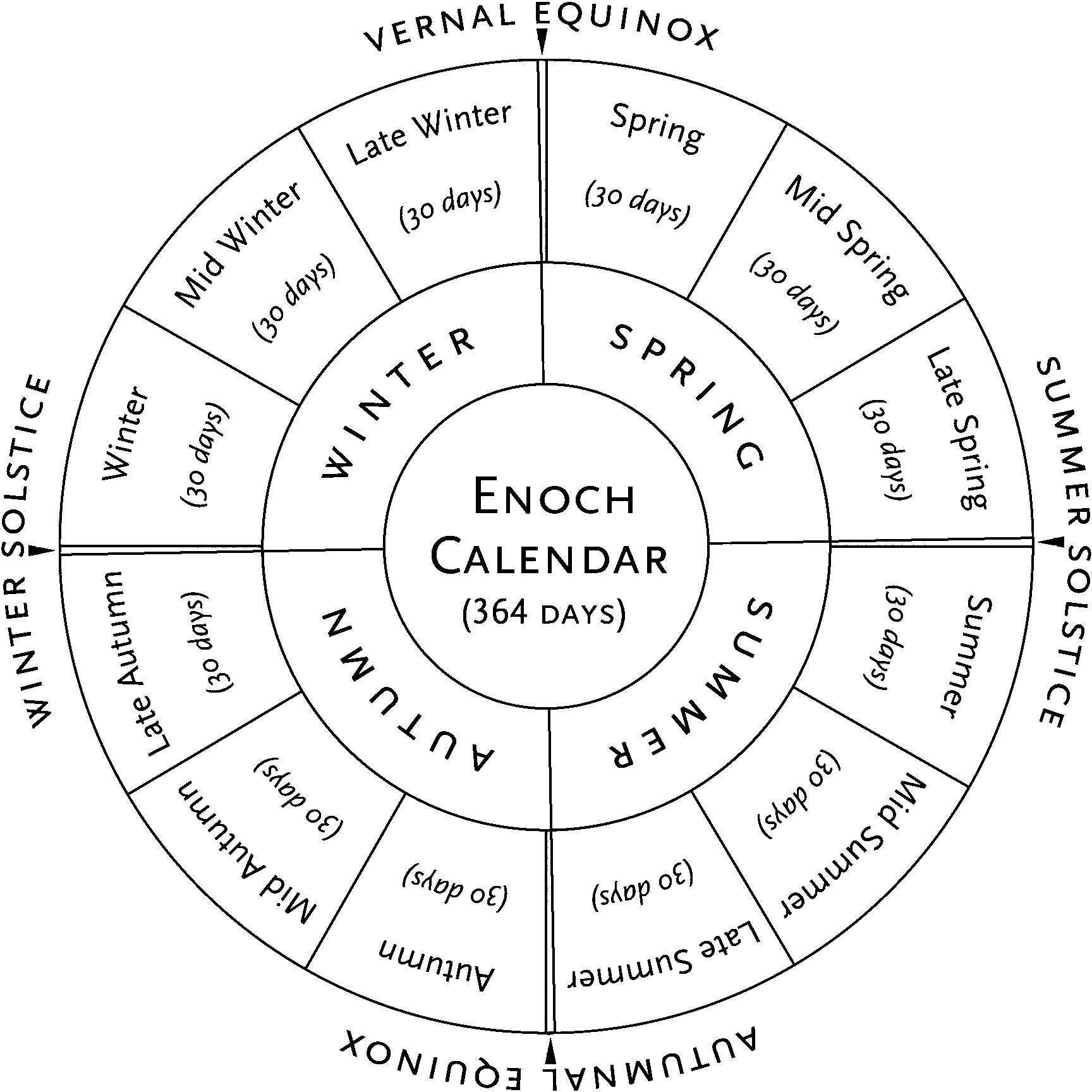 |
The Enoch Fixed (EF) calendar is very simple because it always has 364 days in every year, never inserting any "leap days" as does the usual Enoch Calendar. Every year begins on a Sunday. The year is composed of 12 months of 30 days each, with 4 season marker days occurring always on a Saturday, representing the spring and fall equinoxes and summer and winter solstices. The arrangement is shown in Fig. 1, which also gives my suggested month names. Thus every quarter-year begins on a Sunday which is the day after one of the four season markers. The actual year has 365.24 days, but the Enoch Fixed calendar never adds any leap days, so it rotates through the seasons by about 1.24 days every year. Thus, the day 1 Summer on the EF calendar could fall on any Sunday of the our Gregorian year, not necessarily only in the summer time. That is another reason that I've tended to avoid it because it seems confusing the way it migrates through the seasons. The names of the months make much more sense in the usual (not Fixed) Enoch calendar, which inserts entire weeks when necessary to keep the calendar aligned with the seasons.
The Holy days on the Enoch calendar include the usual Hebrew holy days, as well as the first day of each month. The four seasonal marker days are also holy, and the first day of each quarter is especially holy because each is always a Sunday. Of special interest in this article is that the Feast of Trumpets occurs on Sun 1 Autumn. My current model for the Enoch calendar includes 28 holy days,[3] so there is a one in thirteen chance (28/364) that any given day is a sacred day.
What has the Feast of Trumpets to do with earthquakes? It occurs on the first day of autumn, which is 1 Autumn on the EF calendar (1 Tishri on the Hebrew calendar). It is the day when God is said to judge the world every year, calling most to repentance. This is done with the blast of a trumpet, designed to get everyone's attention. In the scriptures, the trumpet blast is associated with shaking the earth. For example, on Mt. Sinai, the earth shook at the long blast of the trumpet (Ex. 19:16-19) and the walls of Jericho to fell at the blast of the trumpet (Josh 6:20).
The Feast of Trumpets begins a ten-day period in which people are allowed to repent and reconcile themselves with God. The judgment is not certain until the day of Atonement (10 Autumn EF or 10 Tishri Hebrew). Thus, every year, man is given a chance to make his peace with God.
Moreover, the Feast of Trumpets is also associated with the beginning of the Millennium. The Feast of Trumpets is the first day of the seventh month, symbolizing the beginning of the Millennium on the first day of the seventh thousand years. There were seven priests who each give a blast on the trump on that day, symbolic of the seven angels who sound the trump at the beginning of the Millennium (Rev. 8-10). Thus, it is the association of the Feast of Trumpets with earthquakes which caught my attention and which led to this study.
What is the starting point for reckoning Enoch Fixed Year? Before writing this article I had made the tentative assumption that the year 1 SPRING on the EF calendar began near the birth of Christ, similar to my model for the usual Enoch Calendar. If so, then the tsunami this year would have been on the day 1 Autumn in the year named 10 AUTUMN. That would mean that the year would have corresponded to the year of ATONEMENT, which is the holy day at the end of the judgment period starting at TRUMPETS. It was this double coincidence of day and year which led me to do the research published here.
Not only are the odds against so many perfect alignments incredibly unlikely to have been by random chance, it is also impressive how the years are also symbolic of the event. For example, Adam and Eve leaving the Garden of Eden at the Beginning of Mortality in the year END PASSOVER is appropriate, because it marked the end of the Garden Period. The Great Flood occurring in the year DELUGE DAY is a bull's-eye and the birth and ministry of Christ occurring at the beginning of periods, and his resurrection occurring the year of FIRSTFRUITS from the ground are also all perfect hits. Thus, there is no question in my mind that the Pentecost correlation is correct.
| Event | Date | EF day | EF YEAR |
|---|---|---|---|
| Beginning | 26 Mar 4001 BC | Begin Summer | END PASSOVER |
| Ark Day | 9 Nov 2343 BC | Tabernacles | DELUGE DAY |
| Great Deluge | 16 Nov 2343 BC | End Tabernacles | DELUGE DAY |
| Exodus | 9 Apr 1462 BC | Esther | END PASSOVER |
| Manna Begins | 10 May 1462 BC | Easter | END PASSOVER |
| Christ to Priest | 14 May 1 BC | Easter | 1 MID-SPRING |
| Begin Ministry | 6 Apr 30 | Passover | 1 LATE SPRING |
| Resurrection | 3 Apr 33 | Easter | FIRSTFRUITS |
| Day of Pentecost | 22 May 33 | Firstfruits | FIRSTFRUITS |
| Arrive Salt Lake | 24 July 1847 | Tabernacles | FIRSTFRUITS |
| Trumpets Tsunami | 26 Dec 2004 | Trumpets | ARK DAY |
This new correlation means that the recent tsunami occurred on 1 Autumn (Trumpets) in the year 10 MID-AUTUMN rather than 10 AUTUMN. The day 10 MAu is not a holy day on the EF calendar, so the dramatic impact of it having occurred in the year 10 AUTUMN (ATONEMENT) is lessened, but there still may be important significance attached to the date. To see why, we need to review the events of the Great Flood in more detail.
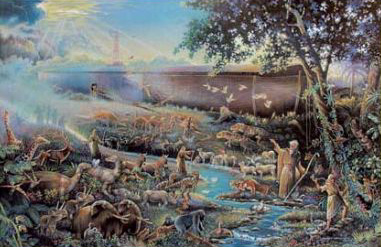 |
And the Lord said unto Noah, Come thou and all thy house into the ark, . . . For yet seven days, and I will cause it to rain upon the earth forty days and forty nights; and every living substance that I have made will I destroy from off the face of the earth. (Gen. 7:1,4)I have named that day "Noah's Ark" day because it was an important calendrical day, being closely tied to the baptism of Jesus Christ.[6] On the Hebrew calendar, Noah's Ark day fell on 10 Heshvan, the 10th day of the second month of autumn. That day corresponds to 10 Mid-Autumn on the EF calendar. It is not an official holy day on the Hebrew calendar, but it still has some important significance. The more important day is 17 Heshvan, Deluge Day, when the flood actually began. Deluge Day on the EF calendar is 17 Mid-Autumn, and is one of the holy days.
What happened on this archetypal day, 10 Heshvan, besides beginning to load the ark? Here the Book of Jasher, which is perhaps the best non-Biblical source for ante-diluvian history,[7] fills in many details to the story of the Great Flood. We are told that on that day, the Lord began to warn the inhabitants of the earth to repent by causing earthquakes and storms:
And on that day, the Lord caused the whole earth to shake, and the sun darkened, and the foundations of the world raged, and the whole earth was moved violently, and the lightning flashed, and the thunder roared, and all the fountains in the earth were broken up, such as was not known to the inhabitants before; and God did this mighty act, in order to terrify the sons of men, that there might be no more evil upon the earth.
And still the sons of men would not return from their evil ways, and they increased the anger of the Lord at that time, and did not even direct their hearts to all this.
And at the end of seven days, in the six hundredth year of the life of Noah, the waters of the flood were upon the earth. (Jasher 6:11-13)
Thus, on 10 Heshvan (corresponding to 10 Mid-Aut on the EF calendar), the Lord caused a huge earthquake and broke up the fountains of the deep (tsunami?) in order to terrify the inhabitants of the earth to call them to repentance, so that he would not have to destroy the world. But the inhabitants not only did not repent, they did not even "direct their hearts to this," which sounds like they didn't even connect the catastrophes with God at all. Does any of this sound familiar?
To me it is interesting that the symbolism of the day of the recent tsunami (Trumpets, EF) and also the year it occurred (10 MAU of NOAH'S ARK) both symbolize a time when the Lord caused earthquakes to call mankind to repentance just before the Great Flood. Also both days begin a period of time given to man in which to repent, being ten days (or years) in the case of Trumpets and seven days (or years) in the case of 10 MAu.
The results were negative on both counts. None of the earthquakes or volcanoes occurred on either Trumpets nor on the day Quake. There was, however, one notable earthquake which occurred on such a similar date that it seems worthy of note.
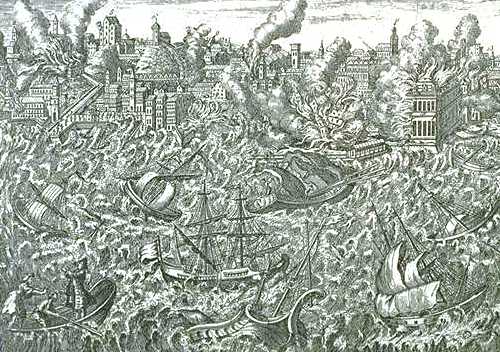 |
In fact, it was also a major influence on philosophy, because many people began to question how God could allow such a disaster to happen. One source states: "Many contemporary writers, such as Voltaire, mentioned the earthquake in their writings. The Lisbon earthquake was used to call into question the existence of God, defined to be innately good in the Christian faith, using the basic argument that such a god should not permit such a tragedy to occur."[11] It is always amazing to me that people decide in their minds how God should act, rather than read his word to find out what he says about himself. In this case, one finds that he not only permits such disasters, but he actually causes them. God makes it clear that he caused the Great Flood which depopulated the whole earth. The Lisbon earthquake and the recent Indian Ocean earthquake are just drops in the bucket compared to that.
The Lisbon earthquake occurred on the autumn equinox, 0 Autumn, on the Enoch Fixed calendar, the day preceding the Feast of Trumpets, 1 Autumn. That weekend always has those two successive EF holy days. So, while strictly speaking it did not fall on the Feast of Trumpets, it may have been close enough to include the same symbolism. Moreover, it occurred on the same days on the Sacred Round calendar as the recent earthquake, that is, the next day, Sunday, was the day 13 Dragon as in the case of the recent tsunami. Those two Sundays were separated by exactly 250 years of 364 days and also 350 sacred rounds of 260 days. So here we have a very similar devastating earthquake happening on the same holy weekend of the Enoch Fixed calendar. One might think that such big earthquakes occur commonly, but the Lisbon quake was found in an almanac which listed a mere 43 deadly earthquakes and volcanoes over the last 2,000 years. One more data point is hardly conclusive, but we can calculate the odds of this happening by chance. The chance of two random dates being on the same holy weekend of the EF calendar is 2/364, times 1/5 of being on the same days on the Sacred Round, or 1/910. So the chances of one date in a list of 43 being on the same weekend is 43/910 or 1/21, which is right at the threshold of where statisticians usually ascribe importance to the find.
 |
You can imagine my surprise when the second date on the list, an earthquake in Iran which killed 200,000 on Tue 22 Dec 856 (26 Dec 856 Gregorian) also fell on 1 Mid-Autumn (EF) and also 4 Skull (SR). The chance of the second date falling on the exactly the same day on both calendars is only 1 in 1,820,[13] so that really caught my attention. It immediately sparked another theory that deadly disasters might on days when a holy day on the Enoch calendar coincides with the day Skull. If that turned out to be true, it would seem to me that what as important to the Lord was not that he was causing an earthquake (corresponding to the day Quake), but rather that people were dying (Skull). If so, then one would only expect this result to apply to earthquakes in which many people died. Knowing the importance of determining the criteria for a statistical study before the data is processed, I looked over the list of events to see if all of them killed many people. The answer was no. Seven of the events killed under 1,000 people, so I decided to eliminate them from the second study. Thus, I did the two studies simultaneously, one study of 43 dates looking for events on Trumpets and/or Quake, and the second study of 36 dates looking for events on any EF holy day and the day Skull.
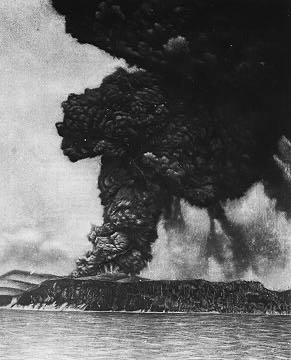 |
Another famous eruption, which was apparently inadvertently omitted from the list of 36 being considered, was that of Mt. Tambora in Indonesia, beginning 5 Apr 1815 am*, which was 5 Skull. It reportedly killed 192,000 when the resultant tidal wave is included. It so darkened the skies around the world that it caused the "Year Without a Summer" in 1816 in on the other side of the earth in Vermont.[14]
Table 2 summarizes the positive results. Twelve of the 36 dates are listed in the table, along with the dates on which the event began. The exact local time of day is important because the day on the current model of the Enoch Fixed calendar begins at 6 p.m. and the day on the Sacred Round begins at 6 a.m. Thus, the double alignment days of the EF and SR calendars only last for either 12 hours of daylight or 12 hours of night. The local solar times were calculated from data from United States Geological Survey data,[15] and are listed in the table as am, am*, pm or pm*. Here the * (star) refers to before 6 am or after 6 pm (when the stars shine).
| Location | Date | Sacred Round | Enoch Fixed | Mag. | Deaths |
|---|---|---|---|---|---|
| Mt. Vesuvius* | 24 Aug 79 am | 4 Skull | 1 Mid-Aut | volc. | 16,000 |
| Damghan, Iran* | 22 Dec 856 | 4 Skull | 1 Mid-Aut | ? | 200,000 |
| Ardabil, Iran* | 23 Mar 893 | 10 Skull | — | ? | 150,000 |
| Lisbon, Portugal* | 1 Nov 1755 am | 12 Temple | 0 Autumn | 8.7 | 70,000 |
| Krakatoa | 26 Aug 1883 am* | 12 Skull | 1 Winter | volc. | 36,000 |
| Gansu, China | 25 Dec 1932 am | 13 Serpent | 1 Summer | 7.6 | 70,000 |
| Chile* | 24 Jan 1939 pm* | 11 Skull | 9 Mid-Sum | 8.3 | 30,000 |
| Tangshan, China | 28 Jul 1976 am* | 8 Serpent | — | 7.5 | 242,000 |
| Tabas, Iran | 16 Sep 1978 pm* | 9 Skull | — | 7.7 | 25,000 |
| Mexico | 19 Sep 1985 am | 8 Skull | 1 Late Spr | 8.0 | 25,000 |
| Kobe, Japan | 17 Jan 1995 am* | 8 Grass | 10 Autumn | 7.2 | 5,000 |
| Turkey | 17 Aug 1999 am* | 4 Serpent | — (15 MSp) | 7.4 | 17,000 |
It is seen from the table that seven of the 36 dates being considered fell on the day Skull, 8 fell on a holy day on the EF calendar, and the five listed in italics fell on both. What are the chances that these results occurred because of random chance? That is, if one were to consider many lists of 36 totally random dates, how often would one find similar results due to blind chance. That is easy to calculate.
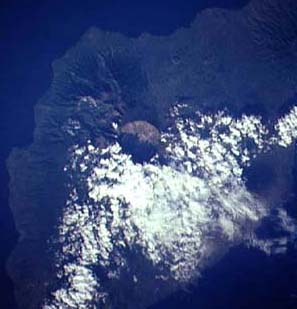 |
 |
One would expect 1.75 days out of 35 being studied to fall on Skull just from blind chance because there is a 1 in 20 chance that any given day will be Skull (1.75 = 35 x 1/20). The chance that 6 dates would fall on Skull is 1/144.[18] That means that if were to examine 144 lists of absolutely random dates, we'd expect one of them that have 6 dates on Skull just by chance. Most statistical studies conclude that if there is less than a 1/20 probability that it was due to chance that the result is meaningful. To me it is not compelling, but it suggests that further studies could be done to verify the result.
Enoch Fixed. Seven of the 42 dates fell on a holy day on the Enoch Fixed calendar.[19] Is that meaningful? There are currently 28 recognized holy days on the EF calendar so one would expect one of every thirteen days to be a hit, or 3.23 hits just from random chance (3.23 = 42 x 1/13). That means that there is a 1/35 chance of finding seven EF holy days on any list of 42 random dates.[20] This by itself is not compelling, but again is unusual enough to be called meaningful in a statistical study. Just for the record, I also checked the usual Enoch Calendar and found six hits, which may also be significant enough to suggest more study. The reason I did not pursue that result is that my model of exactly when to insert the extra leap-week is still a work in progress, so the results would not be conclusive. The power of the EF and SR calendars is that once one day in history is determined, all dates can be calculated with certainty.
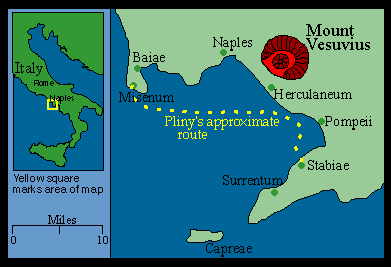 |
Thus, the results of my preliminary study are that the evidence is rather compelling that the largest and deadliest earthquakes and volcanoes tend to happen on days with are both holy days on the Enoch Fixed calendar and also the day Skull on the Sacred Round much more often than would be expected by chance. To me this indicates that God may well be scheduling these earthquakes according to his sacred calendars. He has already made it clear that they are a method which he will use to warn the world of impending judgments; this new evidence is only adding the idea that they are scheduled.
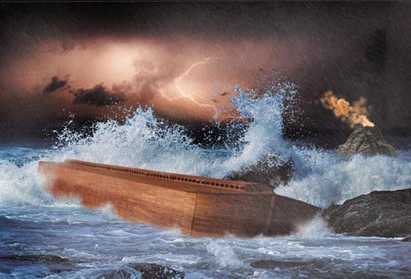 |
On contemplating its significance, it occurred to me that it might well have been the day on which most people died during the Flood. The rain began to fall and the fountains of the deep erupted on 16 Nov (Gen. 7:11). The rain fell for forty days (Gen. 7:12), and the waters increased on the earth and eventually "bare up" the ark (Gen. 7:17). The ark was apparently not hit by a tidal wave, but was gently lifted up. Had all the people on earth died by that time? They most likely would have been seeking higher ground. But there came a day when higher ground was no longer available, but "all the high hills, that were under the whole heaven, were covered" (Gen. 7:16). The "waters prevailed" for 150 days (Gen. 7:24) and Noah didn't leave the ark until a year had elapsed (Gen. 8:14). So the flood was a long process that entirely immersed and cleansed the earth. While we are told the exact day of many events such as when the mountain tops were first seen again, we are not told exactly when most people died. Now it appears that it was not necessary to explicitly record that day because it is carved so clearly into the sacred calendars. "Deluge Day" occurred some 26 days after the Flood began, while the water was still rising, and likely about the time that high hills were being covered. Thus, it is here proposed that the most people died in the Flood on the day Thu 12 Dec 2343 BC, and that day will be called "Deluge Day" in my articles.
One more note on probabilities is that if I had discovered this date first and then had done the above study looking for EF holy days falling on the day Skull, then I would have been able to count all five of the winners instead of just four. The chance of finding five such dates in a random list of 36 dates is only 1 in 2,700,000.[26] So however one looks at it, it appears to be a real discovery that killer disasters have in the past tended to occur on EF holy days falling on Skull.
This study indicates that many of the greatest disasters in history occurred on the day Skull on the Sacred Round, the day symbolizing death. Does that mean that we should avoid taking trips or going skiing on that day? Absolutely not! That is what the ancient Mayans did, avoiding planning weddings or any important events on the "unlucky" days, which were about every third day. The results of this study only apply to the greatest disasters in history. When I looked at smaller or less deadly earthquakes, the effect greatly diminished or disappeared. The day Skull comes around every twenty days and only a handful of them in history had disasters. Some of the great patriarchs were most likely born on the day 1 Skull, such as Adam's grandson Enos (Sat 2 Jan 3765 BC) and his son Cainan (Sun 30 May 3675 BC). Death is a necessary step in our progression, and is not "unlucky" in any way.
The recent disastrous earthquake and tsunami occurred on the Feast of Trumpets on the Enoch Fixed calendar, a day symbolic of angelic trumpet blasts which cause the earth to quake. Research was undertaken to determine whether or not that was a chance coincidence and also whether other devastating earthquakes have followed a similar pattern. The first result is that the date of the tsunami may well have been meaningful because it happened also in the year corresponding to when the Lord reportedly caused earthquakes to call the world to repentance before the Great Flood. However, this preliminary study indicates that killer earthquakes do not tend to fall on the EF Feast of Trumpets, but instead they do tend to fall on EF holy days which coincide with the day Skull on the Sacred Round. It was also concluded that, even as the recent earthquake did not follow this pattern, the Lord is not constrained at all to continue to follow any known pattern in the future. Thus, while we should feel warned to repent, we still have no way of knowing when the future world-scale destruction of the wicked might occur.
(This section was added on 5 Jan 2015.) The calendar name was later changed from Enoch Fixed Calendar to Uniform Enoch Calendar (abbreviated UE) which seemed to be more descriptive. In 2013 a better correlation to our Gregorian Calendar was discovered and it appeared that the correlation used in this article was simply in error by 14 days. (See "Uniform Enoch Calendar Witnesses Religious History" for details.) If so, that would have invalidated all of the conclusions of this article that refer to the Enoch Fixed Calendar. Then in 2014 it was discovered that there are two versions of the Uniform Enoch Calendar. The primary version is the one discovered in 2013, but the secondary version (used for second witnesses to another sacred calendar) differs by 14 days and is identical to the correlation used in this article. (See "Uniform Hebrew and Enoch Calendar Cooperation", Section 5 for details.) Thus, the results of this article stand, using the secondary UE version (abbreviated UE2).
The question now arises whether or not the primary correlation of the Uniform Enoch Calendar may also play a role in the dates of great earthquakes and volcanoes. This subject probably deserves a new and separate study, but a few comments can be made here based on the study being reported in this article.
Looking back at Table 2 at the last entry (Turkey), the EF date listed is 15 Mid Spring which is not a holy day. The Sacred Round date missed being Skull by only a few hours, so the event was counted as a "miss", but listed because it was very close to a "hit". The primary UE Calendar differs by 14 days from the one in this article, and it turns out that the Turkey earthquake was on 1 Mid Spring (UE), which indeed is a holy day. If it is assumed that the most deaths began a few hours later, then the day could be reckoned as 5 Skull (SR). If that is allowed, then the event would be a double hit (with both dates in italics).
Moreover, the huge volcanic event at Mt. Tambora, Indonesia, in 1815 (one of the largest explosions in history) is mentioned just above Table 2 as having first been recorded hundreds of miles away before dawn on 5 Apr 1815. It was not included in the study because in my attempt to be unbiased and objective, it was not allowed because for some reason it had not been listed in the almanac list employed in the study. But if that oversight is ignored and the event included, and if it might have begun a few hours earlier on the afternoon of 4 Apr 1815, then it is an exact match of the Turkey earthquake, having begin on 5 Skull (SR) and also on 1 Mid Spring (UE).
Another double hit would also have occurred using the primary UE Calendar. The Tangshan event occurred on 14 Late Winter (UE), which is the Feast of Esther. Again, if it allowed to shift the start time by a few hours, it too would be a double hit, also being on 9 Skull (SR).
| Location | Date | Sacred Round | Uniform Enoch | Mag. | Deaths |
|---|---|---|---|---|---|
| Mt. Vesuvius* | 24 Aug 79 am | 4 Skull | 1 Mid Aut2 | VEI-5 | 16,000 |
| Damghan, Iran* | 22 Dec 856 | 4 Skull | 1 Mid Aut2 | ? | 200,000 |
| Ardabil, Iran* | 23 Mar 893 | 10 Skull | — | ? | 150,000 |
| Lisbon, Portugal* | 1 Nov 1755 am | 12 Temple | 0 Autumn2 | 8.7 | 70,000 |
| Mt. Tambora | 4 Apr 1815 pm | 5 Skull | 1 Mid Spr | VEI-7 | 192,000 |
| Krakatoa | 26 Aug 1883 am* | 12 Skull | 1 Winter2 | VEI-6 | 36,000 |
| Gansu, China | 25 Dec 1932 am | 13 Serpent | 1 Summer2 | 7.6 | 70,000 |
| Chile* | 24 Jan 1939 pm* | 11 Skull | 9 Mid Sum2 | 8.3 | 30,000 |
| Tangshan, China | 28 Jul 1976 am | 9 Skull | 14 Late Win | 7.5 | 242,000 |
| Tabas, Iran | 16 Sep 1978 pm* | 9 Skull | — | 7.7 | 25,000 |
| Mexico | 19 Sep 1985 am | 8 Skull | 1 Late Spr2 | 8.0 | 25,000 |
| Kobe, Japan | 17 Jan 1995 am* | 8 Grass | 10 Autumn2 | 7.2 | 5,000 |
| Turkey | 17 Aug 1999 am | 5 Skull | 1 Mid Spr | 7.4 | 17,000 |
| Indian Ocean | 26 Dec 2004 am | 13 Dragon | 1 Autumn2 | 9.0 | 200,000 |
Table 2 from the original paper has been modified to include all of these new results and shown here as Table 3. It includes Mt. Tambora, with its starting time and also those of the Tangshan and Turkey events modified by a few hours. Dates on the secondary version of the UE Calendar are shown with the subscript 2. The earthquake causing the tsunami which inspired this article is also included for completeness. It occurred on the UE2 holy day Trumpets (1 Autumn). The only reason it had not been included in the study was that it was too recent to be in the almanac used as the source list. The Magnitude column (Mag.) lists the Richter Scale for earthquakes, and Volcanic Explosivity Index for volcanoes.
It is seen that now the number of double hits (shown in italics) that occur both on Skull (SR) and also a UE holy day has increased from 5 in 36 (in Table 2) to 8 in 37 (the 37th being Mt. Tambora). That is a very statistically significant increase and thus the conclusion becomes even more compelling that killer volcanoes and earthquakes tend to happen on the day Skull (SR) and a holy day (UE) much more often than would be expected by random chance.